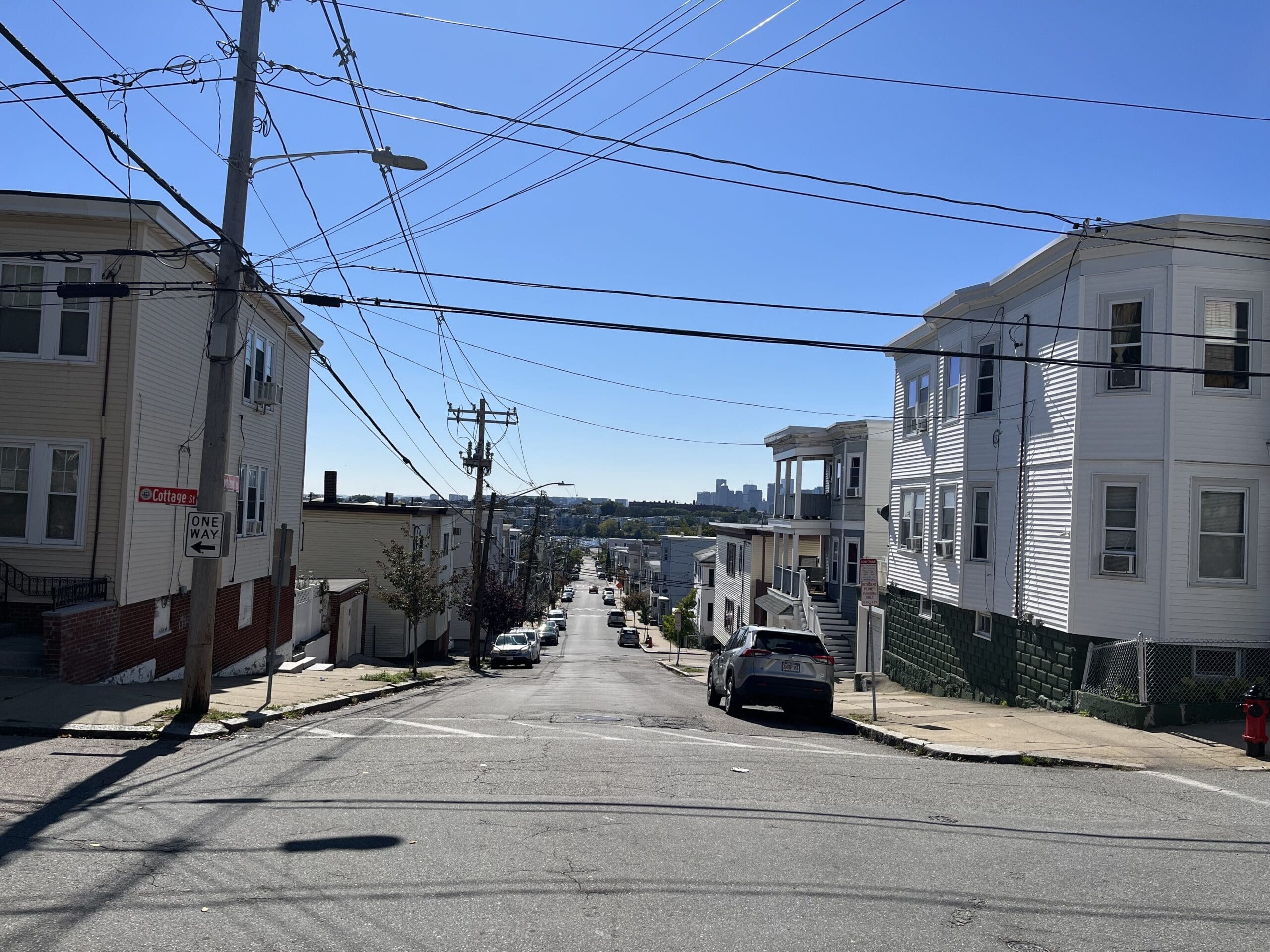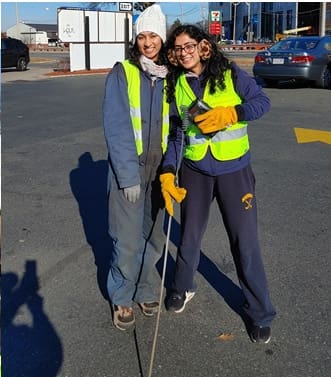Growing up around Codman Square in Boston’s Dorchester neighborhood, Judith Foster routinely smelled gas on the street. The gas company didn’t seem to care enough to fix it. She also disliked the lack of trees in her neighborhood, which starkly contrasted with the lush natural world of her native Jamaica and other wealthier, whiter neighborhoods in her area. City officials didn’t seem to care much about tree scarcity, either.
It wasn’t until she was an adult that she discovered the secret connection between the stench of gas and the absent trees. Greater Boston’s aging, failing gas infrastructure has produced thousands of smelly methane leaks from pipelines under the streets, some serious enough to create explosion risks. But the many more minor leaks also killed off trees by replacing vital oxygen in the soil and choking the roots.
The needless tree death is especially frustrating for Foster, who started a nonprofit in 2014 dedicated to reconnecting people to nature. “Trees are fundamental to our physical and mental well-being,” she says. “And when trees don’t thrive, people don’t thrive.”
That’s why CLF is suing National Grid, the utility company that provides natural gas to much of the northeast United States. The company has ignored the gas leaks killing off trees in Foster’s neighborhood of neat triple-deckers. And when those leaks wither trees, they contribute to long-standing social and health inequities across the city.
National Grid needs to fix its leaky, faulty pipes, but that’s just the beginning. Geothermal energy offers an accessible alternative that’s safer for people and the environment, and it’s past time to make the switch.
Urban trees have countless benefits
The burning of fossil fuels like gas is overheating our planet, causing extreme heat (among other issues) in urban neighborhoods like Foster’s. Dorchester has fewer trees than the average Boston neighborhood, and on a hot summer day, Foster can feel the heat radiating from sidewalks, roads, and parking lots. This heat, known as the heat island effect, can have deadly consequences in neighborhoods without much tree cover.
The heat island effect can lead to higher air pollution and climate-damaging emissions. That in turn aggravates respiratory diseases like asthma and makes heat-related illnesses worse and more frequent. Foster says the poor air quality in Dorchester negatively affects her voice and notes that lower-income people can’t afford air filters to protect themselves. She’s not alone – researchers have found that Black residents like Foster are 40% more likely to live in areas with rising rates of heat-related illnesses.
A robust urban tree canopy could help. In addition to providing shade, trees cool the air by releasing water vapor from their leaves, keeping the environment more comfortable for all of us. Studies show that if streets like Foster’s in Dorchester had thriving trees, then daytime temperatures could drop up to seven degrees. Additionally, trees help filter air pollution, making every breath we take a little cleaner.
Foster wants everyone to benefit from a flourishing tree canopy and protection from gas leaks. She says, “Whatever’s happening to the planet, it’s also happening to us as well … The people who are most affected aren’t even aware [of the gas leaks]. Something needs to change.”
Unfortunately, widespread “natural” gas leaks make a thick tree canopy impossible in many neighborhoods, including Jamaica Plain, South End, and Foster’s home, Dorchester.
The problem with natural gas
So-called “natural” gas is primarily composed of methane, a gas driving climate change that’s even more potent than carbon dioxide. (The gas has no odor, but gas companies include a smelly additive to make leaks easier to detect.) In 2023, New England generated about half of its electricity from this noxious pollutant. It also provides heat to about a third of Massachusetts homes.
According to Heather Govern, CLF’s Vice President for Clean Air and Water, “Along with killing trees, worsening asthma, and posing fire and explosion threats, the natural gas we use to power and heat our buildings releases more methane emissions than any other source in our region.”
What makes the gas leaks problem so dire? The city installed many of our underground gas pipes before 1970, with an astonishing one in four installed before 1940. In other words, significant portions of this key infrastructure carrying highly explosive gas have slowly deteriorated under our feet for almost a century. These outdated cast iron pipes break with predictable frequency, which can lead to major leaks. Meanwhile, minor leaks spring as the pipes degrade.
As of March 2025, National Grid’s own data reveals more 6,000 leaks in Massachusetts it has neglected to repair, including in Foster’s Dorchester neighborhood. “All of these decades that I’ve been smelling it, there were actual leaks,” Foster marveled. Across Greater Boston, investigators hired by CLF uncovered 15 gas leaks that were severe enough to cause an explosion risk and immediately reported those to National Grid.
How do gas leaks kill trees?
Many studies show a connection between excessive methane in the soil and sick or dying trees. Even National Grid admits that vegetation dying for no apparent reason indicates a gas leak. This is because more methane equals less oxygen in the soil. Less oxygen equals suffocation and a slow death for many trees.


Methane also damages roots, making trees more vulnerable to falling in floods or strong winds.
Claire Corcoran, an arborist who has lived in the South End of Boston for almost a quarter of a century, has seen this firsthand. One of the major leaks in her neighborhood spewed gas outside a bilingual school that her friends’ children attended. After discovering dangerous leaks up and down the street, she called 911.
A National Grid representative showed up but left without taking action. Just four months later, a single storm felled four mature trees along the street, including one her friend used to take “first day of school” photos underneath.
Corcoran attributes the loss to methane-damaged roots and considers it a miracle that no one was hurt. Those trees once provided shade and cleaner air for the children she knew. As an arborist, Corcoran knew that “trees actually get more valuable; they provide more ecosystems and benefits to the community as they grow.” Now, replanted trees will take 20 to 30 years to provide those same benefits.
Researchers studying trees in Chelsea, Massachusetts, discovered that, on average, dead or dying trees were 30 times more likely to be exposed to methane than thriving trees. The study found a measurable association between toxic methane leaks and the failing health of the trees. Investigators hired by CLF found more than 200 trees getting poisoned or near death from methane pollution.

Who is National Grid poisoning with these gas leaks?
In addition to Chelsea, South Boston, and Dorchester, CLF’s investigators also discovered serious leaks in the Boston neighborhoods of Chinatown, East Boston, Jamaica Plain, Mattapan, Roslindale, Roxbury, South End, and along the Commonwealth Avenue Mall in Back Bay. Most of these neighborhoods are lower and middle-income and home to Black and Brown communities or immigrants, meaning they already have more pollution and a smaller tree canopy than wealthier, whiter neighborhoods.
Tania Castro-Daunais, a member of Mothers Out Front and resident of East Boston, says that “air quality is a huge issue, especially here in East Boston and Chelsea.” She connected the lack of trees to the high rates of air pollution and asthma her community faces. The issue is personal to her. “Anything we can do to remedy any part of these issues, like paying more attention and getting rid of gas leaks, makes a huge difference to our communities every day,” she explains.
How is CLF fighting back and protecting communities from gas leaks?
“We’re suing to hold National Grid accountable for the harm they are causing to our shade trees and communities,” says Govern. “If we succeed, National Grid will have to step up to fix dangerous gas leaks.” The plaintiffs in the case include residents of neighborhoods impacted by gas leaks, like Foster, and organizations like GreenRoots and East Boston Mothers Out Front.
Success would also mean accelerating the transition to renewable energy sources. CLF has long pushed utilities to transition away from natural gas by building more geothermal heating and cooling systems. While fixing leaks will protect trees and people in the short term, this is just a patch on a bigger problem. No energy source is free of risks or tradeoffs, but renewable energy like geothermal is much safer than fossil fuels like natural gas.
Those toxic fuels will never be safe, not for trees, communities, or the environment. With alternatives like networked geothermal swiftly becoming economical, it’s time to kick natural gas to (and out from under) the curb.
Clean, renewable energy projects, like networked geothermal, will end noxious methane leaks, reduce the severity of heat islands, decrease the risk of fires and explosions, and slow the climate crisis. It’s a win-win-win for everyone involved, particularly for communities already overburdened by pollution and other health risks.
Foster puts it simply: “It shouldn’t just be the connected who are the beneficiaries [of fixed gas leaks].” National Grid has been allowing toxic pollution to poison precious trees and damage the health of primarily lower-income and minority communities. CLF is holding them accountable to keep neighborhoods like Foster’s safe, healthy, and livable. Methane will never be a safe form of energy. It’s time to replace methane with alternatives that will allow us all to thrive.
